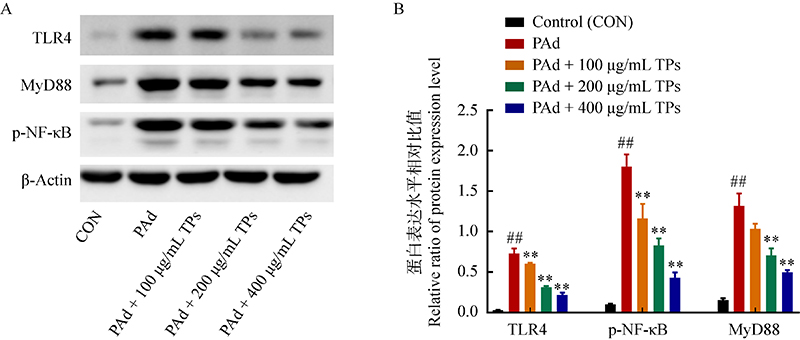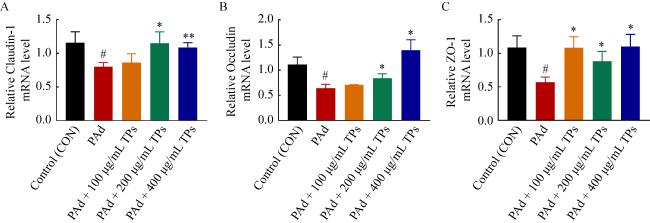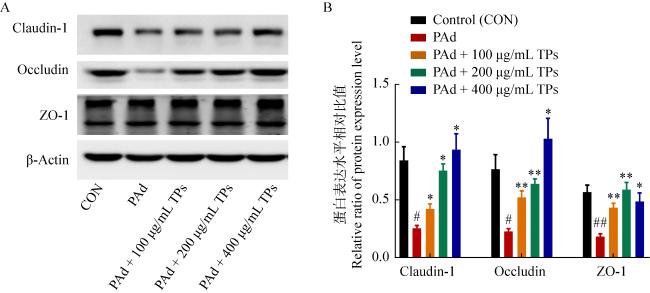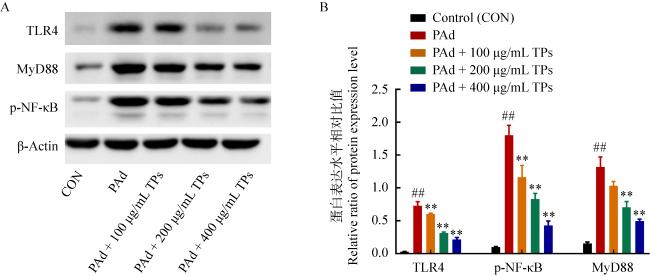 PDF(782 KB)
PDF(782 KB)


 PDF(782 KB)
PDF(782 KB)
 PDF(782 KB)
PDF(782 KB)
银耳多糖对肠道屏障的影响及作用机制
Effects of Tremella fuciformis polysaccharides on intestinal barrier and its functional mechanism
 ({{custom_author.role_en}}), {{javascript:window.custom_author_en_index++;}}
({{custom_author.role_en}}), {{javascript:window.custom_author_en_index++;}}以棕榈酸刺激人结肠癌上皮细胞Caco-2构建高脂膳食模式下的紧密连接蛋白损伤模型,研究银耳多糖对肠道屏障的影响及作用机制。通过检测细胞活力、细胞完整性、氧化还原水平、炎症因子含量、紧密连接基因和蛋白表达量,以及炎症信号通路表达水平,发现400 μg/mL TPs银耳多糖对Caco-2细胞无毒性,能够提升细胞SOD和CAT含量并降低MDA含量,抑制促炎因子IL-1β、TNF-α、IL-6释放,提升紧密连接蛋白Claudin-1、Occludin和ZO-1的mRNA和蛋白表达水平,通过抑制TRL4/MyD88/NF-κB炎症信号通路下调促炎因子分泌。银耳多糖通过抗氧化、抑制炎症因子分泌、提升紧密连接蛋白表达参与维护肠道屏障。
Palmitic acid was used to stimulate human colon cancer epithelial cells Caco-2 to construct a tight-junction protein injury model under high fat diet for studying the effect of Tremella fuciformis polysaccharides on intestinal barrier and its functional mechanism. By measuring cell viability, cell integrity, redox level, inflammatory factor content, tight junction gene, protein expression level, and inflammatory signaling pathway expression level, it was found that 400 μg/mL T. fuciformis polysaccharides was non-toxic to Caco-2 cells, and could increase SOD and CAT content and decrease MDA content, inhibit the release of pro-inflammatory factors IL-1β, TNF-α and IL-6, enhance the mRNA and protein expression levels of tight junction proteins Claudin-1, Occludin and ZO-1, and down-regulate the secretion of pro-inflammatory factors by inhibiting the inflammatory signaling pathway of TRL4/MyD88/NF-κB. T. fuciformis polysaccharides maintained the intestinal barrier by means of anti-oxidation, inhibiting the secretion of inflammatory factors and elevating the expression of tight junction protein.

银耳多糖 / 棕榈酸 / 肠道炎症 / 肠道屏障 {{custom_keyword}} /
Tremella fuciformis polysaccharides / palmitic acid / inflammatory bowel disease / gut barrier {{custom_keyword}} /
表1 qRT-PCR引物联序列Table 1 Primers’ sequences for qRT-PCR |
| Gene | Forward primer (5ʹ→3ʹ) | Reverse primer (3ʹ→5ʹ) |
|---|---|---|
| GAPDH | CTCCTCCTGTTCGACAGTCA | CGACCAAATCCGTTGACTCC |
| Claudin-1 | CACCGTCTGTGTTTGAGCA | CAAACCACCGCTTACAGATG |
| Occludin | GACTATGTGGAAAGAGTTGAC | ACCGCTGCTGTAACGAG |
| ZO-1 | TTCACGCAGTTACGAGCAAG | TTGGTGTTTGAAGGCAGAGC |

图1 棕榈酸和银耳多糖对Caco-2细胞活力和完整性的影响 A:不同浓度TPs对细胞活力影响;B:TPs和PAd对细胞活力影响;C:TPs和PAd对细胞完整性的影响. PAd组与CON组相比,#P<0.05,##P<0.01;Pad+TPs处理组与PAd组相比,*P<0.05,**P<0.01. 下同Fig. 1 Effects of palmitic acid (PAd) and Tremella fuciformis polysaccharides (TPs) on cell viability and TEER value of Caco-2. A: Effects of TPs concentration on cell viability; B: Effects of TPs and PAd on cell viability; C: Effects of TPs and PAd on cell integrity. PAd vs. CON, #P<0.05 and ##P<0.01; PAd+TPs treatment group vs. PAd, *P<0.05 and **P<0.01. The same below. |

图4 银耳多糖对棕榈酸诱导的紧密连接蛋白mRNA表达量的影响 A:Claudin-1水平;B:Occludin水平;C:ZO-1水平Fig. 4 Effect of TPs on PAd-induced tight junction protein mRNA expression. A: Claudin-1 level; B: Occludin level; C: ZO-1 level. |

图5 银耳多糖对棕榈酸诱导的紧密连接蛋白表达量的影响 A:Western blot检测Claudin-1、Occludin、ZO-1的蛋白条带;B:Claudin-1、Occludin、ZO-1的相对表达量Fig. 5 Effects of TPs on PAd-induced tight junction protein expression. A: Protein bands of Claudin-1, Occludin and ZO-1 were detected by Western blot. B: Relative expression of Claudin-1, Occludin, and ZO-1. |

图6 银耳多糖对TRL4/MyD88/NF-κB信号通路的影响 A:Western blot检测TLR4、MyD88、p-NF-κB的蛋白条带;B:TLR4、MyD88、p-NF-κB的相对表达量Fig. 6 Effects of TPs on TRL4/MyD88/NF-κB signaling pathway. A: Protein bands of TLR4, MyD88, and p-NF-κB were detected by Western blot. B: Relative expression of TLR4, MyD88, and p-NF-κB. |
| [1] |
{{custom_citation.content}}
{{custom_citation.annotation}}
|
| [2] |
{{custom_citation.content}}
{{custom_citation.annotation}}
|
| [3] |
{{custom_citation.content}}
{{custom_citation.annotation}}
|
| [4] |
{{custom_citation.content}}
{{custom_citation.annotation}}
|
| [5] |
{{custom_citation.content}}
{{custom_citation.annotation}}
|
| [6] |
{{custom_citation.content}}
{{custom_citation.annotation}}
|
| [7] |
{{custom_citation.content}}
{{custom_citation.annotation}}
|
| [8] |
{{custom_citation.content}}
{{custom_citation.annotation}}
|
| [9] |
{{custom_citation.content}}
{{custom_citation.annotation}}
|
| [10] |
{{custom_citation.content}}
{{custom_citation.annotation}}
|
| [11] |
{{custom_citation.content}}
{{custom_citation.annotation}}
|
| [12] |
{{custom_citation.content}}
{{custom_citation.annotation}}
|
| [13] |
The incidence of autoimmune diseases is increasing along with the expansion of industrial food processing and food additive consumption. The intestinal epithelial barrier, with its intercellular tight junction, controls the equilibrium between tolerance and immunity to non-self-antigens. As a result, particular attention is being placed on the role of tight junction dysfunction in the pathogenesis of AD. Tight junction leakage is enhanced by many luminal components, commonly used industrial food additives being some of them. Glucose, salt, emulsifiers, organic solvents, gluten, microbial transglutaminase, and nanoparticles are extensively and increasingly used by the food industry, claim the manufacturers, to improve the qualities of food. However, all of the aforementioned additives increase intestinal permeability by breaching the integrity of tight junction paracellular transfer. In fact, tight junction dysfunction is common in multiple autoimmune diseases and the central part played by the tight junction in autoimmune diseases pathogenesis is extensively described. It is hypothesized that commonly used industrial food additives abrogate human epithelial barrier function, thus, increasing intestinal permeability through the opened tight junction, resulting in entry of foreign immunogenic antigens and activation of the autoimmune cascade. Future research on food additives exposure-intestinal permeability-autoimmunity interplay will enhance our knowledge of the common mechanisms associated with autoimmune progression.Copyright © 2015. Published by Elsevier B.V.
{{custom_citation.content}}
{{custom_citation.annotation}}
|
| [14] |
The redox balance in the intestine plays an important role in maintaining intestinal homeostasis, and it is closely related to the intestinal mucosal barrier, intestinal inflammation, and the gut microbiota. Current research on the treatment of ulcerative colitis has focused on immune disorders, excessive inflammation, and oxidative stress. However, an imbalance in intestinal redox reaction plays a particularly critical role. Hydrogen is produced by some anaerobic bacteria via hydrogenases in the intestine. Increasing evidence suggests that hydrogen, as an inert gas, is crucial for immunity, inflammation, and oxidative stress and plays a protective role in ulcerative colitis. Hydrogen maintains the redox state balance in the intestine in ulcerative colitis and reduces damage to intestinal epithelial cells by exerting its selective antioxidant ability. Hydrogen also regulates the intestinal flora, reduces the harmful effects of bacteria on the intestinal epithelial barrier, promotes the restoration of normal anaerobic bacteria in the intestines, and ultimately improves the integrity of the intestinal epithelial barrier. The present review focuses on the therapeutic mechanisms of hydrogen-targeting ulcerative colitis.© 2024 Li et al.
{{custom_citation.content}}
{{custom_citation.annotation}}
|
| [15] |
{{custom_citation.content}}
{{custom_citation.annotation}}
|
| [16] |
{{custom_citation.content}}
{{custom_citation.annotation}}
|
| [17] |
The intestinal epithelium of adult humans acts as a differentially permeable barrier that separates the potentially harmful contents of the lumen from the underlying tissues. Any dysfunction of this boundary layer that disturbs the homeostatic equilibrium between the internal and external environments may initiate and sustain a biochemical cascade that results in inflammation of the intestine. Key to such dysfunction are genetic, microbial and other environmental factors that, singularly or in combination, result in chronic inflammation that is symptomatic of inflammatory bowel disease (IBD). The aim of the present review is to assess the scientific evidence to support the hypothesis that defective transepithelial transport mechanisms and the heightened absorption of intact antigenic proinflammatory oligopeptides are important contributing factors in the pathogenesis of IBD.
{{custom_citation.content}}
{{custom_citation.annotation}}
|
| [18] |
Tremella fuciformis, also known as snow mushroom, is an edible mushroom that has historically been popular in herbal and Asian medicine and cuisine. The main polysaccharide ingredients have been extracted and used as treatment in a variety of conditions, demonstrating positive effects in a range of biological functions including those involved in antioxidation, antitumor, antidiabetic, immunomodulatory, and neuroprotective pathways. Studies have demonstrated the role this extract may play in skin antiaging, photoprotection, wound healing, and barrier protection. Most studies have been limited to in vitro and in vivo animal models. Future clinical research is needed to further understand the role of T. fuciformis in dermatology. This review will discuss the existing research findings and potential future applications for T. fuciformis as a treatment in skin conditions.© 2023. The Author(s), under exclusive licence to Springer-Verlag GmbH Germany, part of Springer Nature.
{{custom_citation.content}}
{{custom_citation.annotation}}
|
| [19] |
{{custom_citation.content}}
{{custom_citation.annotation}}
|
| [20] |
{{custom_citation.content}}
{{custom_citation.annotation}}
|
| [21] |
Intestinal Na-nutrient cotransport depends on claudin-2 and claudin-15 mediated Na recycling. Expression of these proteins is coordinately regulated during postnatal development. While expression of claudin-2 and claudin-15 has been studied in inflammatory bowel disease (IBD) and celiac disease (CD), it has not been assessed in other malabsorptive diseases, and no reports have compared expression in children and adults. We used quantitative immunofluorescence microscopy to assess claudin-2 and claudin-15 expression in duodenal biopsies from children and adults with malabsorptive disease and healthy controls. Consistent with previous work in rodents, claudin-2 expression in healthy children was markedly greater, and claudin-15 expression was less, than that in adults. Claudin-2 expression was increased in adults with CD and downregulated in children with graft-versus-host disease (GVHD). In contrast, claudin-15 expression was reduced in adults with GVHD and common variable immunodeficiency (CVID). These data show that one of the two Na/water pore-forming claudins is upregulated in CD and downregulated in GVHD and CVID. The specific claudin whose expression changes, however, reflects the age of the patient (child or adult). We conclude that contributions of claudin-2 and claudin-15 to pathophysiology of and responses to diarrhea in children and adults with GVHD and CVID differ from those in CD and IBD.
{{custom_citation.content}}
{{custom_citation.annotation}}
|
| [22] |
{{custom_citation.content}}
{{custom_citation.annotation}}
|
| [23] |
{{custom_citation.content}}
{{custom_citation.annotation}}
|
| [24] |
{{custom_citation.content}}
{{custom_citation.annotation}}
|
| [25] |
Low-grade inflammation is the hallmark of metabolic disorders such as obesity, type 2 diabetes and nonalcoholic fatty liver disease. Emerging evidence indicates that these disorders are characterized by alterations in the intestinal microbiota composition and its metabolites, which translocate from the gut across a disrupted intestinal barrier to affect various metabolic organs, such as the liver and adipose tissue, thereby contributing to metabolic inflammation. Here, we discuss some of the recently identified mechanisms that showcase the role of the intestinal microbiota and barrier dysfunction in metabolic inflammation. We propose a concept by which the gut microbiota fuels metabolic inflammation and dysregulation.
{{custom_citation.content}}
{{custom_citation.annotation}}
|
| [26] |
{{custom_citation.content}}
{{custom_citation.annotation}}
|
| [27] |
{{custom_citation.content}}
{{custom_citation.annotation}}
|
| [28] |
Tremella fuciformis is an edible medicinal mushroom well known as "Yiner" or "Baimuer" in China and has been used as a Chinese herb for many years. T. fuciformis polysaccharide (TFPS) has been identified as a major bioactive component. Different experimental conditions can obtain different TFPS fractions, which makes TFPS a mixture of different polysaccharides with the molecular weight ranging from 5.82×10Da to 3.74×10Da. The monosaccharides detected in TFPS include mannose, xylose, fucose, glucuronic acid, glucose, and galactose. One characterized TFPS chemical structure consists of a linear (1→3)-linked α-d-mannose backbone with highly branched β-d-xylose, α-d-fucose and β-d-glucuronic acid as the side chains. TFPS shows multiple physiological and healthy promoting effects including immunomodulation, antitumor, anti-oxidation, anti-aging, hypoglycemic, hypolipidemic, neuroprotection, and other effects. As a result, "Tremella Polysaccharide Enteric-coated Capsules" was approved by Chinese Food and Drug Administration (SFDA) in 2002 for treating cancer patients with leukopenia induced by chemotherapy and radiotherapy. It is also used as adjuvant drug for treating chronic persistent hepatitis and chronic active hepatitis. In this chapter, 113 independent studies involving in biochemical, pharmacological, and clinical studies of TFPS during the past 46 years (1972-2018) on the base of PubMed, CNKI (China National Knowledge Infrastructure) and Wanfang database search are summarized. TFPS shows efficacy for all types of human diseases in the reported clinical studies. The structure, molecular mechanisms of the immunomodulation, antitumor, anti-oxidation, anti-aging, hypoglycemic, hypolipidemic, preclinical and clinical efficacy are discussed to provide a general picture of TFPS as a clinically used drug.© 2019 Elsevier Inc. All rights reserved.
{{custom_citation.content}}
{{custom_citation.annotation}}
|
| [29] |
{{custom_citation.content}}
{{custom_citation.annotation}}
|
| [30] |
{{custom_citation.content}}
{{custom_citation.annotation}}
|
| [31] |
{{custom_citation.content}}
{{custom_citation.annotation}}
|
| [32] |
{{custom_citation.content}}
{{custom_citation.annotation}}
|
| [33] |
{{custom_citation.content}}
{{custom_citation.annotation}}
|
| [34] |
Obesity is underpinned by both genetic and environmental factors, including a high-saturated-fat diet. Some mice develop diet-induced obesity (DIO), but others remain diet resistant (DR) despite intake of the same high-saturated-fat diet, a phenomenon that mimics characteristics of the human obese phenotype. Microbiota-colon-brain axis regulation is important for energy metabolism and cognition. Using DIO and DR mouse models, this study aimed to examine gut microbiota, colonic inflammation and cognitive function to elucidate the role of microbiota-gut-brain regulation in DIO. C57Bl6/J mice fed a chronic saturated-palmitic-acid diet for 22 weeks showed significant body weight gain differences, with the top one third gaining 48% heavier body weight than the lower one third. There was significant reduction in gut microbiota richness and diversity in DIO mice but not in DR mice. At the phylum level, DIO mice had increased abundance of Firmicutes and Antinobacteria, and decreased abundance of Bacterioides and Proteobacteria in gut microbiota. DIO mice exhibited reduced tight junction proteins, increased plasma endotoxin lipopolysaccharide (LPS) and increased inflammation in the colon and liver. Recognition memory and spatial memory were impaired in DIO mice, associated with decreased Bacteroidetes. Further examination showed that hippocampal brain-derived neurotrophic factor was significantly decreased in DIO mice (vs. DR). Conversely, DR mice showed no changes in the above parameters measured. Therefore, gut microbiota, colon inflammation and circulating LPS may play a major role in the development of the obese phenotype and cognitive decline associated with a chronic high-saturated-palmitic-acid diet.Copyright © 2018. Published by Elsevier Inc.
{{custom_citation.content}}
{{custom_citation.annotation}}
|
| [35] |
Maintenance of the mucosal barrier is a critical function of intestinal epithelia. Myosin regulatory light chain (MLC) phosphorylation is a common intermediate in the pathophysiologic regulation of this barrier. The aim of this study was to determine whether a membrane permeant inhibitor of MLC kinase (PIK) could inhibit intracellular MLC kinase and regulate paracellular permeability.Recombinant MLC and Caco-2 MLC kinase were used for kinase assays. T84 and Caco-2 monolayers were treated with enteropathogenic Escherichia coli (EPEC) or tumor necrosis factor (TNF)-alpha and interferon (IFN)-gamma to induce barrier dysfunction.PIK inhibited MLC kinase in vitro and was able to cross cell membranes and concentrate at the perijunctional actomyosin ring. Consistent with these properties, apical addition of PIK reduced intracellular MLC phosphorylation by 22% +/- 2%, increased transepithelial resistance (TER) by 50% +/- 1%, and decreased paracellular mannitol flux rates by 5.2 +/- 0.2-fold. EPEC infection induced TER decreases of 37% +/- 6% that were limited to 16% +/- 5% by PIK. TNF-alpha and IFN-gamma induced TER decreases of 22% +/- 3% that were associated with a 172% +/- 1% increase in MLC phosphorylation. Subsequent PIK addition caused MLC phosphorylation to decrease by 25% +/- 4% while TER increased to 97% +/- 6% of control.PIK can prevent TER defects induced by EPEC and reverse MLC phosphorylation increases and TER decreases induced by TNF-alpha and IFN-gamma. The data also suggest that TNF-alpha and IFN-gamma regulate TER, at least in part, via the perijunctional cytoskeleton. Thus, PIK may be the prototype for a new class of targeted therapeutic agents that can restore barrier function in intestinal disease states.
{{custom_citation.content}}
{{custom_citation.annotation}}
|
| [36] |
何亚伦, 曾丽荣, 刘雄, 张铃, 王琼, 2022. 高剂量单宁酸对小鼠肠道屏障和肠道菌群的影响. 生物技术通报, 38(4): 278-287
以正常饮食小鼠和高脂饮食诱导肥胖模型小鼠为对象,研究高剂量单宁酸对小鼠肠道屏障及肠道菌群的影响。通过H&E染色、RT-qPCR、16S rRNA测序等方法进行检测分析。研究发现高剂量单宁酸(400 mg/kg BW)灌胃可使小鼠的体重和进食量降低,增加小鼠体内各肠段内容物的含量,其中结肠内容物的含量显著增加。并且高剂量单宁酸干预后可造成肠道功能损伤及肠道屏障破坏,如杯状细胞数量和隐窝长度减少,及肠道紧密连接蛋白(ZO-1,Occludin及Claudin)表达降低。此外,口服高剂量单宁酸会导致小鼠结肠肠道菌群的多样性发生变化,并增加了SCFA产生菌Alistipes,Ruminococcus和 Blautia以及肥胖负相关菌群Alistipes和Oscillibacter的含量。结果表明,高剂量单宁酸对肠黏膜屏障的破坏影响了小鼠对食物的消化吸收,这可能是高剂量单宁酸干预后小鼠体重快速下降的主要潜在原因。另一方面,高剂量单宁酸所造成的肠道菌群变化也会对小鼠的体重产生影响。
{{custom_citation.content}}
{{custom_citation.annotation}}
|
| [37] |
雷棋怡, 徐杨, 李鹏飞, 2024. 脆弱拟杆菌六型分泌系统对肠道屏障的影响及机制. 生物技术通报, 40(3): 286-295
【目的】 探讨脆弱拟杆菌(Bacteroides fragilis)中六型蛋白分泌系统(T6SS)对肠道屏障的影响及作用机制。【方法】 采用自杀载体构建B. fragilis T6SS缺陷株。建立葡聚糖硫酸钠(DSS)诱导的肠炎小鼠模型,并分别补充PBS,B. fragilis WT和B. fragilis ΔT6SS,随后比较三组小鼠疾病特征、肠道屏障完整性的差异。利用荧光定量PCR和免疫组化检测小鼠紧密连接蛋白的表达。采用非靶向代谢组学比较各组小鼠肠道差异代谢物。【结果】 T6SS缺失不影响B. fragilis的生物活性。与PBS对照组相比,B. fragilis WT明显改善小鼠的体重丢失、结肠长度等疾病指标,表现出对DSS诱导的肠炎的保护性,而B. fragilis ΔT6SS随着T6SS的敲除丧失了对DSS诱导的肠炎的保护性。小鼠血清中异硫氰酸荧光素葡聚糖含量和肠道病理切片均表明B. fragilis T6SS能改善小鼠肠道屏障的完整性。荧光定量PCR和免疫组化均表明B. fragilis T6SS影响肠道紧密连接蛋白的表达。非靶向代谢组学分析表明,与B. fragilis ΔT6SS组相比,B. fragilis WT组显著上调96个肠道差异代谢产物,其中多个代谢产物富集到胆碱能突触代谢和甘油磷脂代谢相关通路。【结论】 拟杆菌T6SS改变肠道代谢组并提高肠道细胞紧密连接蛋白的表达,改善肠道屏障的通透性,参与到拟杆菌对肠道屏障的保护性。
{{custom_citation.content}}
{{custom_citation.annotation}}
|
| [38] |
苏安祥, 胡烨, 胡秋辉, 徐辉, 刘建辉, 谢旻皓, 裴斐, 杨文建, 2022. 金针菇蛋白聚糖对脂多糖诱导的Caco-2/RAW264.7细胞共培养模型炎症的抑制作用. 食品科学, 43(3): 146-151
{{custom_citation.content}}
{{custom_citation.annotation}}
|
| {{custom_ref.label}} |
{{custom_citation.content}}
{{custom_citation.annotation}}
|
 PDF(782 KB)
PDF(782 KB)
 表1 qRT-PCR引物联序列
表1 qRT-PCR引物联序列 图1 棕榈酸和银耳多糖对Caco-2细胞活力和完整性的影响 A:不同浓度TPs对细胞活力影响;B:TPs和PAd对细胞活力影响;C:TPs和PAd对细胞完整性的影响. PAd组与CON组相比,#P<0.05,##P<0.01;Pad+TPs处理组与PAd组相比,*P<0.05,**P<0.01. 下同
图1 棕榈酸和银耳多糖对Caco-2细胞活力和完整性的影响 A:不同浓度TPs对细胞活力影响;B:TPs和PAd对细胞活力影响;C:TPs和PAd对细胞完整性的影响. PAd组与CON组相比,#P<0.05,##P<0.01;Pad+TPs处理组与PAd组相比,*P<0.05,**P<0.01. 下同 图2 银耳多糖对棕榈酸诱导的Caco-2细胞氧化性的影响 A:CAT水平;B:SOD水平;C:MDA水平
图2 银耳多糖对棕榈酸诱导的Caco-2细胞氧化性的影响 A:CAT水平;B:SOD水平;C:MDA水平 图3 银耳多糖对棕榈酸诱导的Caco-2细胞炎症因子释放量的影响 A:IL-1β水平;B:IL-6水平;C:TNF-α水平
图3 银耳多糖对棕榈酸诱导的Caco-2细胞炎症因子释放量的影响 A:IL-1β水平;B:IL-6水平;C:TNF-α水平 图4 银耳多糖对棕榈酸诱导的紧密连接蛋白mRNA表达量的影响 A:Claudin-1水平;B:Occludin水平;C:ZO-1水平
图4 银耳多糖对棕榈酸诱导的紧密连接蛋白mRNA表达量的影响 A:Claudin-1水平;B:Occludin水平;C:ZO-1水平 图5 银耳多糖对棕榈酸诱导的紧密连接蛋白表达量的影响 A:Western blot检测Claudin-1、Occludin、ZO-1的蛋白条带;B:Claudin-1、Occludin、ZO-1的相对表达量
图5 银耳多糖对棕榈酸诱导的紧密连接蛋白表达量的影响 A:Western blot检测Claudin-1、Occludin、ZO-1的蛋白条带;B:Claudin-1、Occludin、ZO-1的相对表达量 图6 银耳多糖对TRL4/MyD88/NF-κB信号通路的影响 A:Western blot检测TLR4、MyD88、p-NF-κB的蛋白条带;B:TLR4、MyD88、p-NF-κB的相对表达量
图6 银耳多糖对TRL4/MyD88/NF-κB信号通路的影响 A:Western blot检测TLR4、MyD88、p-NF-κB的蛋白条带;B:TLR4、MyD88、p-NF-κB的相对表达量/
| 〈 |
|
〉 |